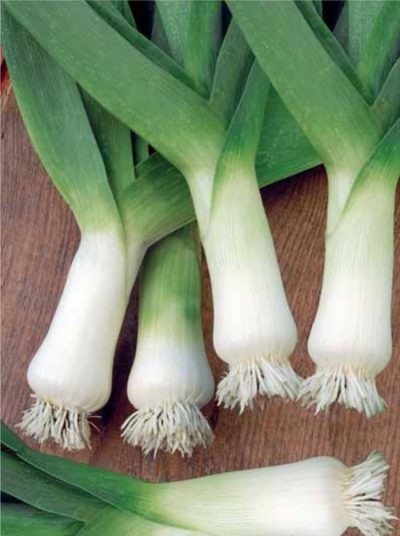
- Authors: "Moravosid" (Czech Republic)
- Year of approval: 1995
- Ripening terms: late ripening
- Appointment: for fresh consumption, for canning
- Yield: high
- Average yield: 320-380 c / ha
- Growing regions: North, North-West, Central, Volgo-Vyatka, TsChO, North Caucasian, Middle Volga, Nizhnevolzhsky, Ural, West Siberian, East Siberian, Far East
- The period from germination to harvest: 125-145 days
- Sevka planting scheme: 15x50-60 cm
- Storage: 5-6 months
Leek Elephant MC is a fairly productive variety, its high taste and commercial qualities have been appreciated by farmers for a long time and are successfully grown both for home use and for commercial purposes.
Breeding history
The leek variety Elephant MC was bred in the middle of the 90s of the last century in the Czech Republic. The famous agricultural company AGROFIRMA MORAVOSEED ("Moravosid") has been engaged in the selection, production and sale of vegetable and flower seeds since 1991. And this variety was one of the first developments of the company's specialists. An application for admission to use was submitted in 1994, and a year later, in 1995, the Elephant MS variety was entered into the State Register and approved for use practically throughout the entire territory of the Russian Federation, as it adapts well to a variety of conditions.
Description of the variety
Leek Elephant MC has many advantages, such as high yield, resistance to low temperatures, including frosty weather, and dry periods. And also it is perfectly preserved for up to six months at a temperature of zero degrees.
Characteristics of the appearance of plants and bulbs
Elephant MC is a large plant of varietal leeks, with an average height of 65-85 cm, but it can grow up to 85-100 centimeters. It has wide leaves of an interesting blue-green color, while there is absolutely no anthocyanin coloration or it is very weak, there is a strong waxy coating.
The bulb is weakly expressed, of medium size, bleached stalk, its length is 15-25 centimeters, its diameter is medium. Plant weight - 200 grams.
Purpose and taste
The taste of the described leek is noted as spicy or slightly spicy. At the same time, many people like the delicious gourmet qualities of Elephanta, which are considered excellent. Suitable for fresh consumption, as well as for canning, home cooking (boiling, stewing, frying), winter storage, it can be dried and frozen.
The product is rich in a complex of minerals, vitamins C, E, B1, B2, PP, carotene. Leeks are able to improve the activity of the liver, gallbladder, increase appetite. It is useful for people suffering from atherosclerosis, metabolic disorders, obesity, gout, kidney and liver stones.
Maturation
The leeks of the described variety are late ripening. From germination to harvesting a ripe crop, 125-145 days pass.
Yield
The yield of Elephanta MC is considered high. On average, the indicators are in the range of 320-380 c / ha.
Growing regions
Regions where you can grow a decent harvest of Elephant MC leeks are:
- northern and Northwest;
- Central and Volgo-Vyatka, as well as the Central Black Earth Region;
- North Caucasus;
- Middle and Lower Volga;
- Ural, Western and Eastern Siberia;
- Far East.
Growing and care
Planting of seedlings of leeks Elephant MC is carried out in March, and transplanting into open ground - in May. The landing pattern is 15x50-60 cm.
The variety is very demanding on the level of moisture and applied top dressing, especially nitrogen. Further dressings at the growing season are performed using superphosphate, urea, nitroammophoska, potassium sulfate.Elephant grows well on fertile, sod, loamy and sandy loam soils, clean of weeds, with a neutral reaction, non-acidic. In order for a long bleached stalk to form, experts recommend hilling.
The culture does not require too complex care. Watering - up to twice a week. A couple of weeks after planting, the first hilling and loosening is carried out. In total, at least four hilling must be done.
Harvesting of leeks Elephant MC is carried out in early October. Plants need to be dug, then pulled out of the soil, cut off. At the same time, roots are left with a length of 2-3 centimeters, the leaves are cut off, leaving a length of about 20 centimeters from the branch.

Since the onion is an unpretentious and cold-resistant plant, it can be planted both in spring and autumn. It is necessary to properly prepare the planting material, competently prepare the garden bed and determine the timing of planting.


The bow is not as unpretentious as it seems. For good growth, you need fertile soil, quality care and nutritious fertilizers. Without top dressing, the bulbs will grow small, and the greens will not be lush. At different stages, it should be fed with different substances. The vegetable needs organic and mineral feeding. A good result for fertilizing onions is the use of folk remedies.

Despite the fact that the onion is a very useful plant, capable of repelling and killing many microbes and bacteria, it itself is often damaged and suffers from various misfortunes. Diseases and pests of onions can significantly reduce the yield. It is necessary to correctly determine the presence of this or that disease and take appropriate measures in time.


















































































